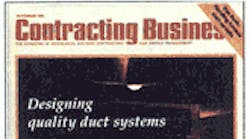The boom in commercial new construction in the first half of the decade was unequaled in U.S. history, particularly office buildings, hotel/motels, and shopping mall development -- whole cities sprang up practically overnight. The boom ended as abruptly as it had started, and the replacement market for HVACR equipment surpassed new construction sales for the first time.
In January 1980, Ronald Reagan was sworn in as president of the United States and with his election, a new conservatism swept the land. At the same time, a high degree of glitz and greed pervaded as witnessed by the junk bond fiascos, the Ivan Boesky affair, and the failures within the banking industry that led to the financial troubles plaguing the real estate and construction industry today.
The HVACR industry was diversifying. Many mechanical systems contractors became just as skilled at installing sophisticated electrical load management systems as they were in handling fire-smoke control systems, industrial heat recovery systems, and commercial boiler tune-ups.
Service was becoming a vital asset in the business mix instead the necessary evil it was once regarded as.
And so, as the industry evolved, so did the magazine ‑‑ in September 1981, under the publishing leadership of Jim McDermott, The Air Conditioning and Refrigeration Business changed its name to Contracting Business Magazine.
The marketplace too began changing with the introduction of scores of new technologies and products. Very early in the decade, Lennox took the industry by storm with its Pulse furnace. Not only was pulse technology new, it helped usher in a new era of heating efficiency and furnace sales.
Up to that point, contractors generally considered furnaces almost a give-away item provided as an add-on to air conditioning sales. The high efficiency furnace changed that. Furnaces became profit generators, often sold by themselves.
But this change didn't come without a price. As more manufacturers got into the high efficiency furnace business, and the efficiencies climbed into mid-80 AFUEs, problems with heat exchangers developed. New heat exchanger designs eventually solved those problems.
The introduction of computers and plasma cutters revolutionized the sheet metal business, changing it from a craft into a manufacturing process.
With the application of scroll compressors in commercial and residential air conditioners and heat pumps, a new era in unitary efficiency was born.
The development of the personal computer affected the entire world – it brought the power of expensive mini and mainframe computers into the home, the office, and the store. It was this invention that gave Design/Build contractors the tools they needed to provide their customers with all the design services engineering firms offered.
As Design/Build contractor-engineers grew adept at using them, they found they could quickly produce multiple solutions to customer problems and present them in a more professional manner. The PC would forever change the mechanical systems sales process — both residentially and commercially.
With the advent of PCs, controls technology changed, focusing on distributed processing. This development led to real growth of the energy management and facility automation business.
In the early 1980s, contractor-manufacturer relations hit all-time lows over the battle for the service business. Contracting Business, in an effort to turn this situation around, began hosting dialog meetings between major manufacturers and their key contractor customers.
In 1986, the market shifted and for the first time, replacement sales surpassed new construction.
During the late 1980s, the HVACindustry finally became bored with its infatuation with efficiency and began looking into issues of indoor air quality, health, and comfort — three factors that studies showed impacted heavily on productivity and profitability in the workplace.
Contractor franchise groups — Mr. Build, Dial One, Service America — sprang into life and then faded into the background as residential contractors sought ways to provide whole house service for their customers.
As the decade wound to a close, the industry faced the specter of regulation again as the Environmental Protection Agency began making more noise about the ozone depletion problem. Refrigerant use as we knew it was about to change forever.








